Cardiff pond maintenance, Carlsbad pond maintenance, Carmel Valley pond maintenance, Del Mar pond maintenance, Encinitas pond maintenance, La Costa pond maintenance, LaJolla pond maintenance, Leucadia pond maintenance, North County pond maintenance, Point Loma pond maintenance, Poway pond maintenance, Rancho Santa Fe pond maintenance, San Diego pond maintenance, and San Marcos pond Maintenance. North County Ponds and Rancho Santa Fe pond service. North County Ponds 760-710-1632 P.O. Box 8053 Rancho Santa Fe, California 92067. North County Ponds is north San Diego's best pond cleaning and pond maintenance service pond cleaning service. For a clean, healthy, beautiful pond, our pond maintenance is second to none. We are pond service professionals and are passionate about clean, healthy koi ponds. Let North County Ponds care for your koi pond. Keep your pond beautiful! Call us today for a free pond consultation: North County Ponds (760-710-1632) Dirty pond? North County Ponds is the answer for clearer, cleaner pond water, pond muck removal, aquatic plant management, pond algae control, pond filter and pond pump maintenance, pond equipment installation, koi health, pond health, and general pond and lake management. North County Ponds services the greater area of north San Diego county including: Rancho Santa Fe ponds, Del Mar ponds, La Jolla ponds, Carmel Valley ponds, Solana Beach ponds, Encinitas ponds, Carlsbad ponds, and Fallbrook ponds. |
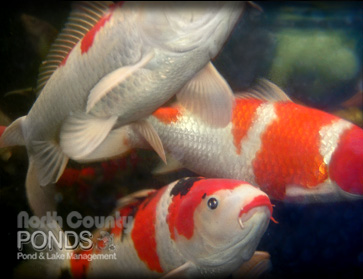 |
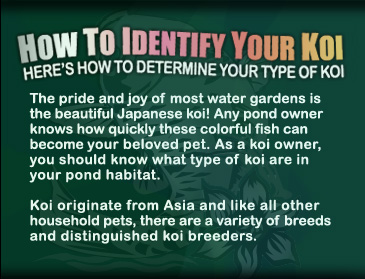 |
 |
|
|
 |
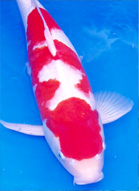 |
 |
| Kohaku are red and white koi with an even intensity of color. The main color should be snow white, with no yellowing and should exhibit a fine luster. Patterns are “stepped” and are recognized by consecutive islands of color. A classic Kohaku exhibits strong red coloring on it’s head, followed by a 3 or 4 “stepped” pattern. “Tancho” Kohakus exhibit 1 lone head marking followed by a distinct “stepped” pattern. Kohakus are a must for every koi fish pond. Probably the most common of the Japanese koi. |
 |
 |
 |
| A Kohaku brandishing stand alone color on the head is considered a Tancho and is judged in a separate class. Ideally, the Tancho marking should be centered and circular in shape, resembling the sun pattern on the Japanese flag. A very symbiotic fish in Japan. A full grown Tancho should be pure white in color with the one distinct red “Tancho” mark on it’s head. Another prized fish in Japanese koi culture which is held in high regard. A quality Tancho should exude brilliant whiteness on it’s body. Since this is it’s dominate color, it needs to shine. |
 |
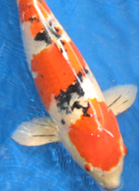 |
 |
| Once known as the Taisho Sanke, or Taisho Sanshuko, koi of the Sanke variety look very much like Kohaku that have been spattered with ink. As a matter of fact, the two varieties, Sanke and Kohaku, are closely linked and are the only koi varieties with traceable bloodlines. A Sanke looks like a Kohaku combined with a Bekko. The red color should be deep and even, and well balanced when viewed without the black sumi. On the other hand, the black sumi should also be well balanced when viewed separately and should not extend below the lateral line. All the markings should have distinct edges separating the colors and the skin, which should be a snowy white. Tancho Sankes make a great addition to the pond. |
 |
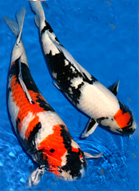 |
 |
| Traditionally, the dominant color in a Showa is their red, with black sumi and white in roughly equal proportions. If more than half the body is red when viewed from above, the Showa is referred to as a Hi Showa. But whereas an Aka Sanke is not a very subtle fish, its Showa equivalent can look stunning. This is due to the amount of black sumi in the pattern, which needs very little white to accent it. This effect is helped along by the pectoral fins and their motoguro, although clear white fins are now acceptable in modern Showa. Hi Showa are sometimes difficult to distinguish from Hi Utsuri, but if any white skin is visible when the koi is viewed from above, the koi is a Showa. One of our favorite koi fish. |
 |
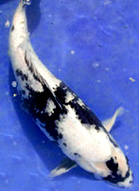 |
 |
Like a Kohaku, Shiro Utsuri are classically simple, two-colored koi. It’s body should be the color of pure snow with a healthy, yet subtle sheen. A Shiro Utsuri is a black fish with white markings, a Shiro Bekko is the reverse, and all Utsuri sumi is of the typical Showa "wraparound" type.
The sumi should ideally be jet black and glossy, as in Showa. A fault is too much black on the fins. Rather than neat motoguro on the pectorals, low-grade Shiro Utsuri exhibit solid sumi at the ball joint, which radiates outward. If this sumi is excessive, the whole fin will appear black. Dorsal and caudal fins are allowed some sumi, but again, if there is too much, the koi will appear unbalanced. |
|
|
|
 |
| If your pond is new or old, large or small, North County Ponds is trained in a variety of pond care services including regular pond maintenance, on-call pond services, pond clean-outs, complete filter system installs, pond water treatments, system cleanings, pond sealing, koi medicating, koi and fish care, algae control, aquatic plant care, and all other aspects of pond and lake management. Call North County Ponds at 760-710-1632 for questions, pricing info, or to schedule a free pond consultation. |
 |
|
| Cardiff pond maintenance, Carlsbad pond maintenance, Carmel Valley pond maintenance, Del Mar pond maintenance, Encinitas pond maintenance, La Costa pond maintenance, LaJolla pond maintenance, Leucadia pond maintenance, North County pond maintenance, Point Loma pond maintenance, Poway pond maintenance, Rancho Santa Fe pond maintenance, San Diego pond maintenance, and San Marcos pond Maintenance. North County Ponds and Rancho Santa Fe pond service. North County Ponds 760-710-1632 P.O. Box 8053 Rancho Santa Fe, California 92067. North County Ponds is north San Diego's best pond cleaning and pond maintenance service pond cleaning service. For a clean, healthy, beautiful pond, our pond maintenance is second to none. We are pond service professionals and are passionate about clean, healthy koi ponds. Let North County Ponds care for your koi pond. Keep your pond beautiful! Call us today for a free pond consultation: North County Ponds (760-710-1632) Dirty pond? North County Ponds is the answer for clearer, cleaner pond water, pond muck removal, aquatic plant management, pond algae control, pond filter and pond pump maintenance, pond equipment installation, koi health, pond health, and general pond and lake management. North County Ponds services the greater area of north San Diego county including: Rancho Santa Fe ponds, Del Mar ponds, La Jolla ponds, Carmel Valley ponds, Solana Beach ponds, Encinitas ponds, Carlsbad ponds, and Fallbrook ponds. |








